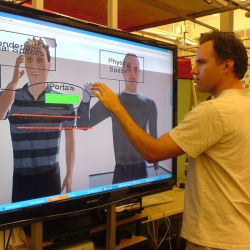
Is there a place for augmented reality (AR) in the work-a-day world? Yes, according to experts who are conducting research with the technology or are familiar with its capabilities. AR provides a view — through head-mounted, handheld or spatial displays — of a physical environment whose elements are augmented by computer-generated virtual imagery.
While much of the work in AR has been focused on consumer applications such as video games, experts say the technology shows promise in the workplace as well. "I think the biggest potential is supporting more fluid and flexible collaboration," says Blair MacIntyre, associate professor at the School of Interactive Computing at Georgia Institute of Technology’s GVU Center, and an expert in augmented reality, computer graphics and human-computer interaction. "By being able to merge information — documents, models, avatar representations of remote participants — with the physical world, we can hopefully build more fluid collaboration systems."
Georgia Tech has several AR projects underway, some of which might some day be applicable to the work environment.
In one project, researchers have created a virtual world that mirrors part of the Georgia Tech campus, and supports both mobile AR clients and desktop 3D clients. "All users see the other users — either as avatars in their view or if they are both using live AR clients, just by seeing each other — and can chat and interact with them," MacIntyre says.
Georgia Tech researchers have also been looking at how to use mixed reality interfaces to virtual worlds to support heterogeneous collaboration. "The goal is to leverage the virtual world as the hub around which work happens, but provide interfaces such as wall-sized interactive portals that allow groups of users in instrumented spaces [for example, conference rooms or offices] to collaborate more effectively" with other remote workers, MacIntyre says.
There’s been lots of interest in mobile AR information browsing, MacIntyre notes, and Georgia Tech is working on a general set of Web data standards and protocols. "From a work point of view, this will open the door to a wide variety of mobile information access applications," he says.
Mobile phones "will have the highest immediate impact on the augmented reality segment," adds Babak Parviz, McMorrow Innovation associate professor of bionanotechnology, self-assembly, nanofabrication and MEMS at the University of Washington, whose work on AR to date has focused on developing contact lenses with simple built-in electronics. The lenses "are the true trail-blazing devices that might bring augmented reality to the mass market," Parviz says.
As computing, imaging, and communication becomes cheaper and more widely available, "we may see the adoption of AR in more regular workplaces for things like arranging meetings to reading emails, making sales presentations, et cetera," Parviz says.



Join the Discussion (0)
Become a Member or Sign In to Post a Comment